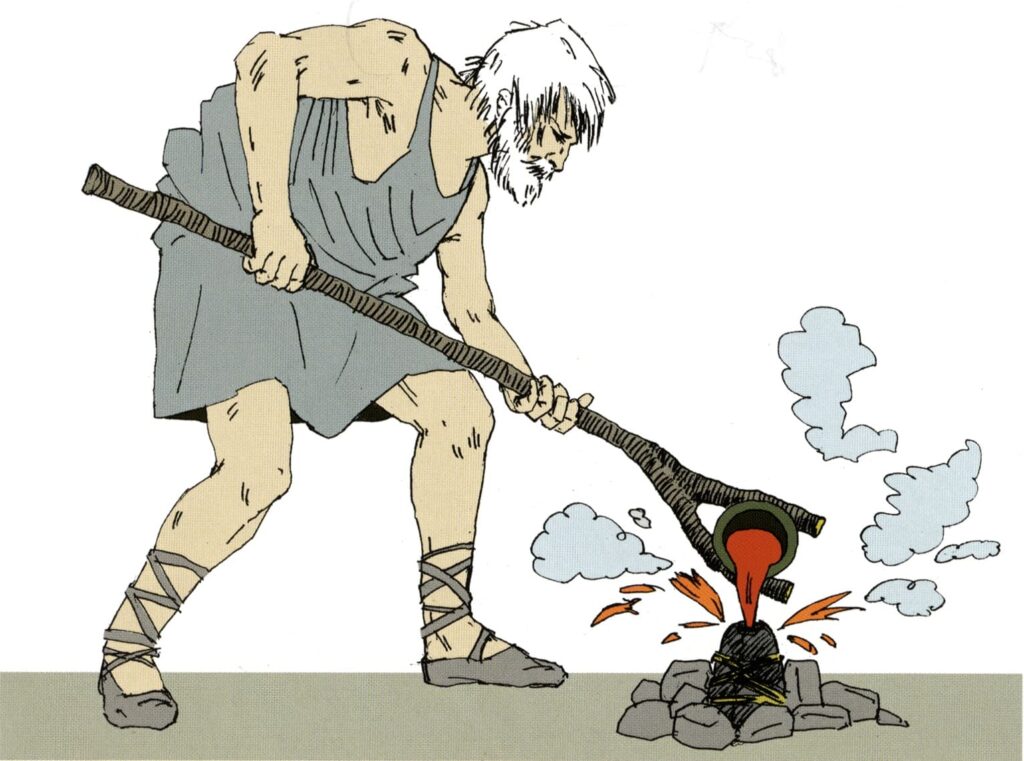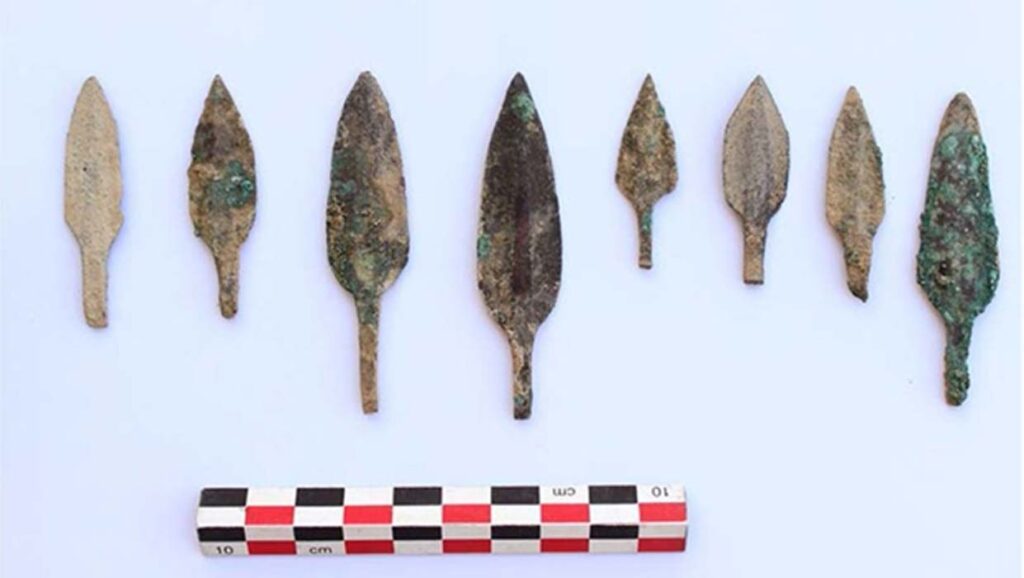In the sprawling annals of human history, few artifacts evoke the essence of ancient warfare quite like the Bronze Age spear. This slender yet formidable weapon stands as a testament to an era that propelled civilization forward, shaping the art of combat and marking a significant leap in metallurgical mastery.
<iframe width=”560″ height=”315″ src=”https://www.youtube.com/embed/SmKKWmnPWaI?si=n_lEJDAyCac9PV_X” title=”YouTube video player” frameborder=”0″ allow=”accelerometer; autoplay; clipboard-write; encrypted-media; gyroscope; picture-in-picture; web-share” allowfullscreen></iframe>
Crafting Mastery: Metallurgy in the Bronze Age

To comprehend the significance of the Bronze Age spear, one must grasp the intricacies of metallurgy during that epoch. Bronze, a fusion of copper and tin, wasn’t merely a material; it symbolized humanity’s leap from Stone Age rudimentary tools to sophisticated weaponry. The craft of alloying these metals ushered in an era of innovation, allowing for sturdier, more durable weapons compared to their stone or early metal counterparts:
- During the Bronze Age, metallurgy was a transformative craft that propelled humanity into an era of innovation. It marked a significant departure from the Stone Age, introducing the art of alloying metals to create bronze—an alloy of copper and tin. This alloy was a game-changer, offering a material far superior to its elemental components;
- The mastery of metallurgy in the Bronze Age wasn’t merely about discovering a new material; it was a testament to human ingenuity and the evolution of technology. The process of smelting ores and combining copper and tin, usually in a ratio of around 90% copper to 10% tin, resulted in a metal stronger and more durable than its predecessors;
- The advent of bronze brought about a revolution in tool and weapon production. Spears, axes, swords, and various other implements crafted from this newfound alloy were sturdier, sharper, and had a longer lifespan compared to their stone or early metal counterparts. This metallurgical advancement not only revolutionized warfare but also facilitated the development of other aspects of society, such as agriculture, architecture, and trade;
- The knowledge of metallurgy during this era wasn’t uniform across civilizations; it varied geographically and evolved over time. Different regions experimented with varying compositions and techniques to produce bronze, showcasing the diverse approaches to this groundbreaking craft. The dissemination of this knowledge through trade routes facilitated cultural exchanges and technological advancements, contributing to the flourishing of Bronze Age societies;
- The mastery of metallurgy wasn’t solely a practical achievement. It held cultural and symbolic significance, symbolizing progress, wealth, and power. The individuals and communities who possessed the knowledge of smelting and forging bronze held a distinct advantage over others, both in warfare and in trade.
The Bronze Age was defined by the transformation wrought by metallurgy. It marked a pivotal moment in human history, where the fusion of copper and tin birthed an alloy that not only shaped tools and weapons but also laid the foundation for the progression of civilization. The legacy of this era’s metallurgical prowess reverberates through history, as it remains a testament to humanity’s relentless pursuit of innovation and mastery over materials.
Evolution of Design: From Function to Form

The design of the Bronze Age spear was a result of the era’s military needs and cultural aesthetics. These weapons, typically ranging from six to eight feet in length, featured a leaf-shaped blade attached to a wooden shaft. The blade’s shape varied across regions, showcasing the fusion of practicality and artistic expression. Intricately crafted and honed, these spears reflected the prowess of their makers.
Technology of spear making in the Bronze Age
In the Bronze Age, crafting a spear involved a blend of metallurgical knowledge, woodworking skills, and an understanding of functional design. The technology behind spear making during this period underwent considerable evolution, showcasing the innovative capabilities of ancient civilizations.
- Materials Selection: The primary components of a Bronze Age spear were the shaft and the blade. The shaft was typically crafted from wood, selected for its durability and flexibility. Various types of wood were used, depending on availability and desired characteristics. Meanwhile, the blade, the critical part of the spear, was made from bronze—a combination of copper and tin. The process of smelting and alloying these metals was a complex yet essential aspect of spear production;
- Metallurgy and Casting: The creation of bronze involved mining ores rich in copper and tin, followed by smelting them at high temperatures to extract the metals. This smelting process required specialized knowledge and furnaces capable of reaching high temperatures. Once the bronze was obtained, it was cast into molds to create the spearheads. These molds were often made of stone, clay, or other heat-resistant materials;
- Forging the Blade: After casting, the rough spearheads underwent further refinement through forging. This involved heating the bronze to malleable temperatures and then shaping and sharpening the blade using tools like hammers and anvils. The craftsmanship involved in forging the spearhead determined its durability, sharpness, and overall effectiveness in combat;
- Hafting: Joining the blade to the shaft, known as hafting, was a critical step. The wooden shaft was prepared by shaping one end to accommodate the spearhead. Binding materials such as leather, sinew, or other durable substances were used to secure the blade to the shaft, ensuring a firm and sturdy connection. The hafting process demanded precision to create a seamless union between the two components;
- Design and Decoration: Beyond functionality, the design of the spear often incorporated artistic elements. Some spearheads featured decorative engravings or embellishments, showcasing the craftsmanship and aesthetic sensibilities of the era. These designs might have held symbolic or cultural significance, adding an artistic touch to the functional weapon.
The technology behind spear making in the Bronze Age reflected the amalgamation of metallurgical expertise, woodworking skills, and artistic expression. It was a process that required specialized knowledge, craftsmanship, and a deep understanding of materials, resulting in a weapon that was not only efficient in warfare but also a testament to the ingenuity and advancement of ancient civilizations.
What was the spear used for in the Bronze Age?
In the Bronze Age, the spear held immense significance as a primary weapon in warfare, showcasing its multifaceted utility beyond mere combat. Here’s how the spear was utilized during that era:
- Warfare and Battle: The spear was a cornerstone of Bronze Age warfare. Its primary function was as a thrusting weapon, utilized by foot soldiers in various formations. The extended reach offered by the spear allowed warriors to engage adversaries from a safer distance, forming the backbone of battlefield strategies. It was crucial in formations like the phalanx, where soldiers armed with spears created a formidable wall of pointed weapons, providing both offense and defense;
- Hunting: Spears were also employed for hunting purposes. The Bronze Age saw a shift from reliance on stone tools to bronze implements, and spears became integral in hunting animals for sustenance. Their length and sharpness made them effective for taking down prey, contributing to food procurement for communities;
- Symbolic and Ritualistic Use: Beyond its utilitarian functions, the spear held symbolic and ritualistic significance. In several ancient cultures, spears were featured prominently in religious ceremonies or rites, often symbolizing power, bravery, or divine connections. Spears were buried alongside revered individuals, serving as offerings or symbols of status in burial rituals, signifying their importance in both life and the afterlife;
- Tool for Daily Life: Beyond combat and rituals, spears had practical applications in everyday life. They were versatile tools used for activities like fishing, farming, and even as a means of personal defense or deterrence against wildlife threats.
The spear’s adaptability and effectiveness in various spheres of life made it a fundamental tool of the Bronze Age. Its significance transcended mere combat, embodying cultural, practical, and symbolic roles that contributed to the fabric of ancient societies.
The Spear in Combat: Tactical Significance
As a primary weapon of the era, the Bronze Age spear held paramount importance in battle formations. Its reach offered a strategic advantage, allowing warriors to engage foes from a safer distance. The phalanx formations, used by civilizations like the Mycenaeans, relied heavily on these spears, forming an impenetrable wall of pointed weapons. The efficiency and versatility of the spear made it a battlefield mainstay for centuries.
Symbolism and Ritual: Beyond Warfare
However, the significance of the Bronze Age spear extended beyond the battlefield. In several ancient cultures, these spears held symbolic importance and were often featured in religious ceremonies, buried alongside revered figures or offered as tributes to deities. Their presence in burial sites speaks volumes about their perceived significance in both life and the afterlife.
Legacy and Influence: Spear’s Enduring Impact
Despite the passage of millennia, the legacy of the Bronze Age spear endures. Its design principles and tactical advantages have echoed through history, influencing the evolution of weaponry in subsequent eras.
From the classical Greek hoplite to the medieval pike formations, the fundamental concepts of the Bronze Age spear continue to resonate in military strategy and design. You might also like our short review of : Bronze Age Spear: A Glimpse into Ancient Warfare
In finale
In conclusion, the Bronze Age spear stands as a relic of innovation and strategic thinking. It represents a pivotal moment in human history, where the fusion of craftsmanship and necessity birthed a weapon that shaped warfare and cultural practices. As archaeologists continue to uncover and study these ancient artifacts, they offer us a profound glimpse into our ancestors’ ingenuity and the evolution of human civilization itself.